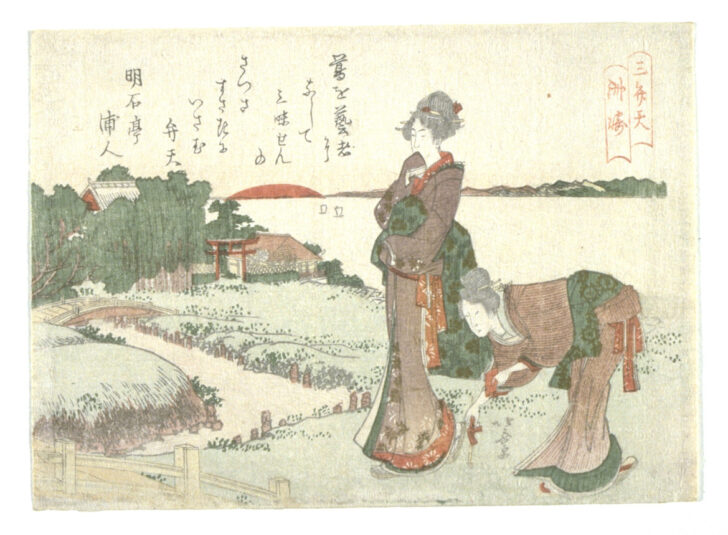Sunrise at Benten Shrine, Suzaki Cape
Katsushika Hokusai

Description
In the final decade of the eighteenth century, there was a severe wave of government censorship against any publications—image or text—that could be construed as political satire or as detrimental to public morals. At first this crackdown had a devastating impact on print publishers and artists, who found themselves in manacles if they attempted to continue their staple products of erotica and pin-up prints of courtesans and actors. They soon rebounded, however, with new formats and new themes. One outlet for artistic genius was the surimono, the privately commissioned print that could avoid the censor’s eye. Usually issued as New Year’s greetings by members of a poetry club or clique, surimono are small in scale and richly decorated with the highest quality pigments, including metallic shades of silver, gold, and copper.
Katsushika Hokusai, who is best known in the West for his landscape prints of Mount Fuji, evokes here a quietly nostalgic scene. Two geisha (itinerant musicians) are shown strolling in the countryside, with the roof of a Shintô shrine in the distance. The backdrop is the rising sun—the give-away that this is a New Year’s print—seen over distant mountains and a calm bay. The women seem unimpressed by nature’s display: one stoops to empty the ashes from her pipe, while the other draws her kimono closely about her, against the chill of the dawn.
M. Graybill
"Courtesans, Cross-Dressers, and the Girl Next Door Images of the Feminine in Japanese Popular Prints"
3/9 - 9/1/02
Subject Matter:
In the final decade of the eighteenth century, there was a severe wave of government censorship against any publications—image or text—that could be construed as political satire or as detrimental to public morals. At first this crackdown had a devastating impact on print publishers and artists, who found themselves in manacles if they attempted to continue their staple products of erotica and pin-up prints of courtesans and actors. They soon rebounded, however, with new formats and new themes. One outlet for artistic genius was the surimono, the privately commissioned print that could avoid the censor’s eye. Usually issued as New Year’s greetings by members of a poetry club or clique, surimono are small in scale and richly decorated with the highest quality pigments, including metallic shades of silver, gold, and copper.
Katsushika Hokusai, who is best known in the West for his landscape prints of Mount Fuji, evokes here a quietly nostalgic scene of two geisha (itinerant musicians) strolling in the countryside, with the roof of a Shintô shrine in the distance. The backdrop is the rising sun—the give-away that this is a New Year’s print—seen over distant mountains and a calm bay. The women seem unimpressed by nature’s display: one stoops to empty the ashes from her pipe, while the other draws her kimono closely about her, against the chill of the dawn. A poem, possibly by Akashi tei urabito, lies above the rising sun in the top left register.
Physical Description:
Two geisha (itinerant musicians) are shown strolling in the countryside, with the roof of Benten Shintô shrine in the distance. The backdrop is the rising sun—the give-away that this is a New Year’s print—seen over distant mountains and a calm bay. One woman stoops to empty the ashes from her pipe, while the other draws her kimono closely about her. A poem lies just above the rising sun in the top left register of the morning sky.
Usage Rights:
If you are interested in using an image for a publication, please visit https://umma.umich.edu/request-image/ for more information and to fill out the online Image Rights and Reproductions Request Form.